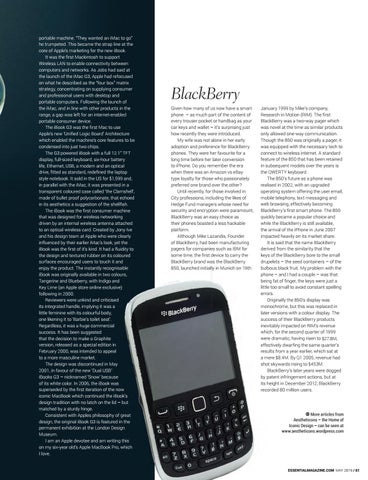portable machine. “They wanted an iMac to go” he trumpeted. This became the strap line at the core of Apple’s marketing for the new iBook. It was the first Mackintosh to support Wireless LAN to enable connectivity between computers and networks. As Jobs had said at the launch of the iMac G3, Apple had refocused on what he described as the “four box” matrix strategy, concentrating on supplying consumer and professional users with desktop and portable computers. Following the launch of the iMac, and in line with other products in the range, a gap was left for an internet-enabled portable consumer device. The iBook G3 was the first Mac to use Apple’s new ‘Unified Logic Board’ Architecture which enabled the machine’s core features to be condensed into just two chips. The G3 powered iBook with a full 12.1” TFT display, full-sized keyboard, six-hour battery life, Ethernet, USB, a modem and an optical drive, fitted as standard, redefined the laptop style notebook. It sold in the US for $1,599 and, in parallel with the iMac, it was presented in a transparent coloured case called ‘the Clamshell’, made of bullet proof polycarbonate, that echoed in its aesthetics a suggestion of the shellfish. The iBook was the first consumer machine that was designed for wireless networking driven by an internal wireless antenna attached to an optical wireless card. Created by Jony Ive and his design team at Apple who were clearly influenced by their earlier iMac’s look, yet the iBook was the first of it’s kind. It had a fluidity to the design and textured rubber on its coloured surfaces encouraged users to touch it and enjoy the product. The instantly recognisable iBook was originally available in two colours, Tangerine and Blueberry, with Indigo and Key Lime (an Apple store online exclusive) following in 2000. Reviewers were unkind and criticised its integrated handle, implying it was a little feminine with its colourful body, one likening it to ‘Barbie’s toilet seat’. Regardless, it was a huge commercial success. It has been suggested that the decision to make a Graphite version, released as a special edition in February 2000, was intended to appeal to a more masculine market. The design was discontinued in May 2001, in favour of the new ‘Dual USB’ iBooks G3 – nicknamed ‘Snow’ because of its white color. In 2006, the iBook was superseded by the first iteration of the now iconic MacBook which continued the iBook’s design tradition with no latch on the lid – but matched by a sturdy hinge. Consistent with Apples philosophy of great design, the original iBook G3 is featured in the permanent exhibition at the London Design Museum. I am an Apple devotee and am writing this on my six-year old’s Apple MacBook Pro, which I love.
BlackBerry Given how many of us now have a smart phone – as much part of the content of every trouser pocket or handbag as your car keys and wallet – it’s surprising just how recently they were introduced. My wife was not alone in her early adoption and preference for BlackBerry phones. They were her favourite for a long time before her later conversion to iPhone. Do you remember the era when there was an Amazon vs eBay type loyalty for those who passionately preferred one brand over the other? Until recently, for those involved in City professions, including the likes of Hedge Fund managers whose need for security and encryption were paramount, BlackBerry was an easy choice as their phones boasted a less hackable platform. Although Mike Lazaridis, Founder of BlackBerry, had been manufacturing pagers for companies such as IBM for some time, the first device to carry the BlackBerry brand was the BlackBerry 850, launched initially in Munich on 19th
January 1999 by Mike’s company, Research in Motion (RIM). The first BlackBerry was a two-way pager which was novel at the time as similar products only allowed one-way communication. Though the 850 was originally a pager, it was equipped with the necessary tech to connect to wireless internet. A standard feature of the 850 that has been retained in subsequent models over the years is the QWERTY keyboard. The 850’s future as a phone was realised in 2002, with an upgraded operating system offering the user email, mobile telephony, text messaging and web browsing, effectively becoming BlackBerry’s first smart phone. The 850 quickly became a popular choice and while the BlackBerry is still available, the arrival of the iPhone in June 2007 impacted heavily on its market share. It is said that the name BlackBerry derived from the similarity that the keys of the BlackBerry bore to the small drupelets – the seed containers – of the bulbous black fruit. My problem with the phone – and I had a couple – was that being fat of finger, the keys were just a little too small to avoid constant spelling errors. Originally the 850’s display was monochrome, but this was replaced in later versions with a colour display. The success of their BlackBerry products inevitably impacted on RIM’s revenue which, for the second quarter of 1999 were dramatic, having risen to $27.8M, effectively dwarfing the same quarter’s results from a year earlier, which sat at a mere $ 8.4M. By Q1 2005, revenue had shot skywards rising to $ 453M. BlackBerry’s later years were dogged by patent infringement actions, but at its height in December 2012, BlackBerry recorded 80 million users.
i More articles from Aestheticons – the Home of Iconic Design – can be seen at www.aestheticons.wordpress.com
ESSENTIALMAGAZINE.COM MAY 2019 / 61
237Aes.indd 61
17/04/2019 11:06
